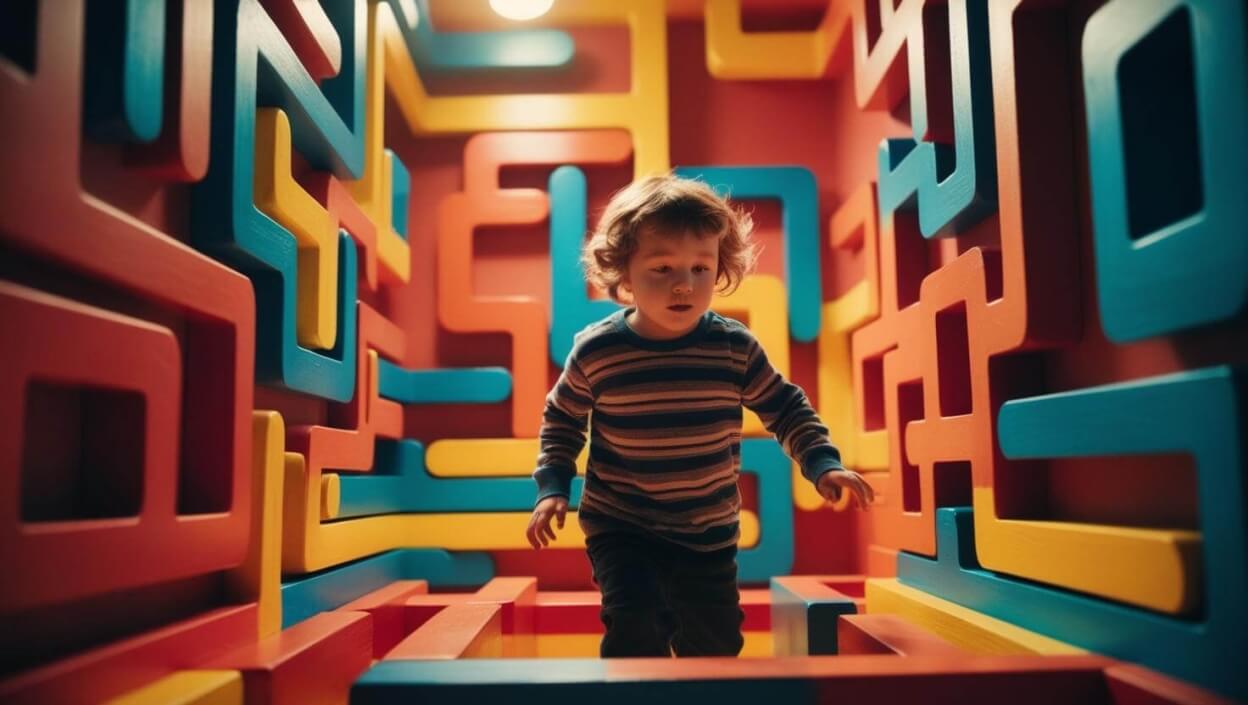Developing Logical Thinking in Children with Mazes - A Parent's Guide
Mazes are more than just fun - they're powerful educational tools supporting children's mental development. By solving them, kids practice logical thinking, planning, and concentration in the form of an engaging game. At mazes4kids.com you'll find everything you need: from a free maze generator to ready-to-print sets!

Mazes support the development of concentration and problem-solving skills in children of all ages
5 Key Benefits of Children Solving Mazes
Every twist and dead end in a maze gives your child an opportunity to practice essential life skills. Here's what your little one gains by regularly solving mazes:
Strategic Thinking
Children learn to anticipate the consequences of their choices, plan their next steps, and analyze alternative paths to reach their goal.
Problem Solving
When encountering obstacles, kids learn to analyze problems, find alternative solutions, and persistently work toward their goal despite difficulties.
Spatial Awareness
Mazes help understand relationships between directions and shapes, which translates to better results in mathematics and navigational skills.
Focus and Concentration
Focusing on finding the exit strengthens the ability to maintain attention for longer periods - a key skill for academic learning.
Patience and Persistence
Overcoming challenging mazes teaches children that success sometimes requires multiple attempts. This builds mental resilience and perseverance - key traits for future success.
Customize difficulty level to match your child's age and abilities
How to Effectively Use Mazes in Everyday Education
Mazes can be easily incorporated into your family's daily routine - all you need is a printed sheet and a bit of creativity. Here are proven strategies to help maximize their educational potential:
Match the Difficulty Level to Your Child's Age
Very simple mazes with wide paths and minimal turns. At this stage, building confidence is most important.
Moderately complex mazes with more turns. You can introduce dead ends, but in limited numbers.
More complicated patterns with multiple dead ends and alternative paths. You can add puzzle elements to solve while navigating the maze.
Our maze generator allows you to adjust the difficulty level to match your child's current abilities in seconds!
Storytelling – Turn the Maze into an Adventure
Instead of asking your child to simply navigate the maze, add an engaging story. Here are a few examples:
- "Help the astronaut get back to the rocket before takeoff!"
- "The knight must reach the castle to save the princess from the dragon."
- "The little kitten is lost in the forest – help it find its way back to mom."
- "The diver must find the hidden treasure at the bottom of the ocean and return to the surface."
Tip for Parents
Encourage your child to tell their own stories while solving the maze. This further develops creativity and language skills.
Introduce Elements of Competition and Fun
Children love challenges and competition. Here's how you can use these natural tendencies:
Race Against Time
Set a timer and see how quickly your child can find the exit. Record times and track progress.
Point System
Award points for each solved maze, with bonuses for more difficult levels or faster times.
Family Challenge
Organize a family maze tournament on the weekend – everyone solves the same set of mazes.
Maze Board Game
Combine several mazes into one large board, add pieces and dice – create your own adventure game!
Looking for ready-made, professionally prepared mazes? Our downloadable maze books offer dozens of patterns at various difficulty levels, perfect for any occasion.
7 Creative Ideas for Maze Activities
Mazes can be used in many unexpected ways. Here are our favorite creative ideas:
1. Artistic Mazes
Download a maze and ask your child to color the path while solving it. You can use a color gradient (e.g., from red to blue) to track progress.
This exercise develops not only logical thinking but also hand-eye coordination and movement precision.
2. 3D Mazes
Print a maze on thicker cardstock, cut out the paths, and create a three-dimensional model using paper and glue. This is a great exercise for spatial thinking.
3. Backyard Maze
Bring the maze into the real world! Draw a large maze with chalk on the sidewalk or arrange it with blocks in your child's room. This makes for fantastic physical activity.
4. Maze Journal
Create a journal of solved mazes with your child. After each one, you can record what was difficult, what was easy, and how your child handled the challenge.
5. Themed Mazes
Use our themed mazes related to seasons, holidays, or your child's favorite characters.
6. Maze with Rewards
Place small stickers or pictures along the correct path. Your child can collect them only when following the right way.
7. Collaborative Maze
Ask two children to solve a maze together - one can move from the entrance, the other from the exit, meeting in the middle.
Frequently Asked Questions About Educational Mazes
Children as young as 2-3 years old can begin their adventure with very simple mazes. It's important to adjust the difficulty level to their age and abilities. Our generator allows you to create mazes suitable even for the youngest children.
There are no rigid rules, but 10-15 minutes a day several times a week is a good start. More important than frequency is regularity and approach - mazes should be fun, not an obligation.
Frustration is a natural part of the learning process. If your child becomes discouraged, return to simpler mazes to rebuild confidence. You can also solve more difficult mazes together, showing strategies for dealing with obstacles.
Start Your Maze Adventure Today!
Hundreds of diverse mazes await you and your child. It's an excellent investment in mental development that's also great fun!